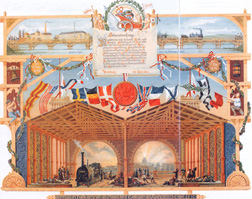The Integration of Infrastructures in Europe before the Great War and after the Second World War in comparison
Sub-project: Integration of Railways

The development of the railway system during the 19th century took place as an interaction between private and public agents, whereby the former often took the initiative in building a track. Based upon these isolated individual projects, visionary plans for large-scale networks soon emerged, that were largely accomplished by about 1870. During this process the necessity arose to integrate infrastructures that were partly built according to different standards.
The central question of the subproject is, how – based on the countries’ and companies’ different qualifications – was a joint (or at least compatible) understanding of harmonisations developed which had to be solved by international exchange (or which maybe even failed) and how were balanced solutions generated. From that perspective, integration is a problem of coordination and negotiation that has to take into account the agents’ horizons of experience as essential limiting conditions. This includes the more or less substantial “experiences of integration” (i.e. contact with other countries) and the societal-political circumstances.
In the subproject “Railways” three pairs of case studies are to be examined more closely, while for each pair one aspect from the first period (about 1860 to 1914) and one aspect from the second period (about 1949 to 1970) will be considered:
a) International infrastructure projects as an example for economic and traffic-related integration and its implementation through factual projects.
b) International passenger traffic as an example for the agreement on operational and qualitative standards.
c) International tariffs as an expression of different economic guiding principles, but also as a matter of coordination and the need for adequate methods (administrative standards) to put them into practice.
After the Second World War the national perspective dominated further development of the railway system. It is displayed e.g. in the development of different technical equipment and different rolling stock concepts motivated by industrial policy, which the transport companies – by then nationalised – could not resist. Even the upcoming European integration left questions of the railways and general traffic considerations uncovered for a long time, although it led to a considerable increase in cross-border transport interdependences. The international cooperation of railway companies and the advancement of institutional foundations went on, but the railway could not participate in the growth of traffic demand.
It was not until the 1980s that new projects for a reanimation of European railway traffic were launched. The liberalisation of the rail-related transport market proceeds and gives new meaning to the agents’ coordination. This research is supposed to make a contribution by collecting impulses from the analysis of previous integration assignments for the future.
